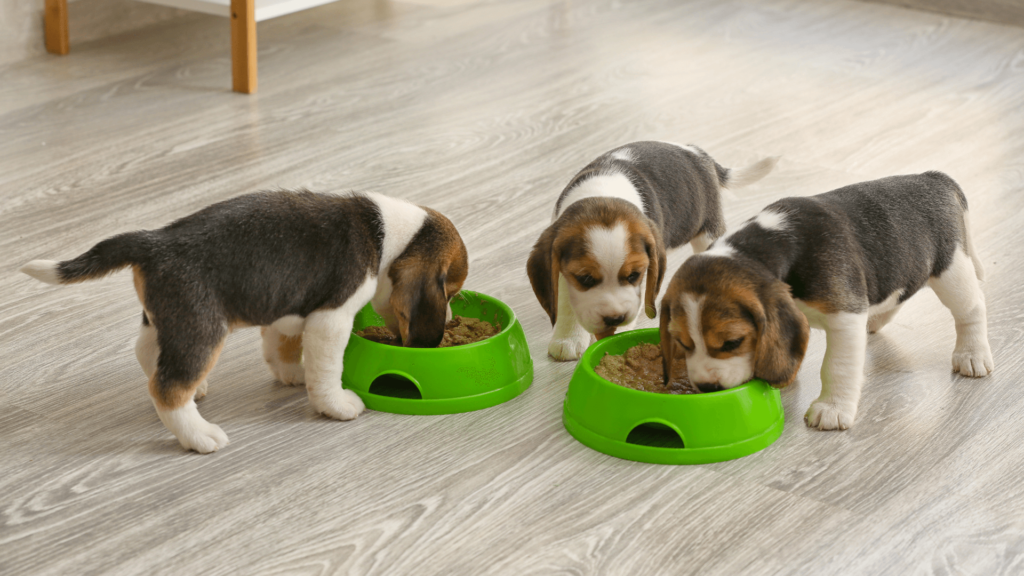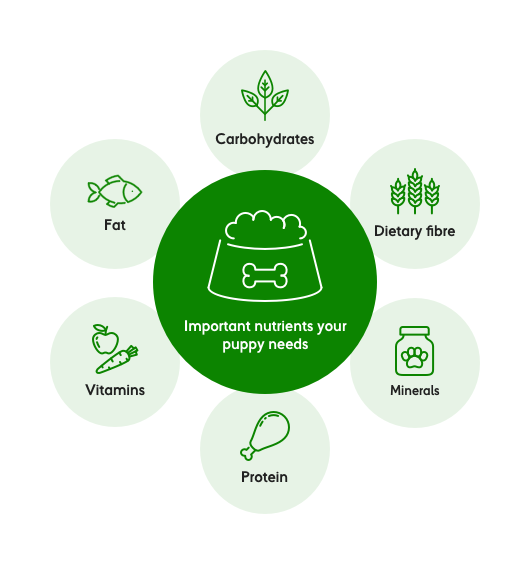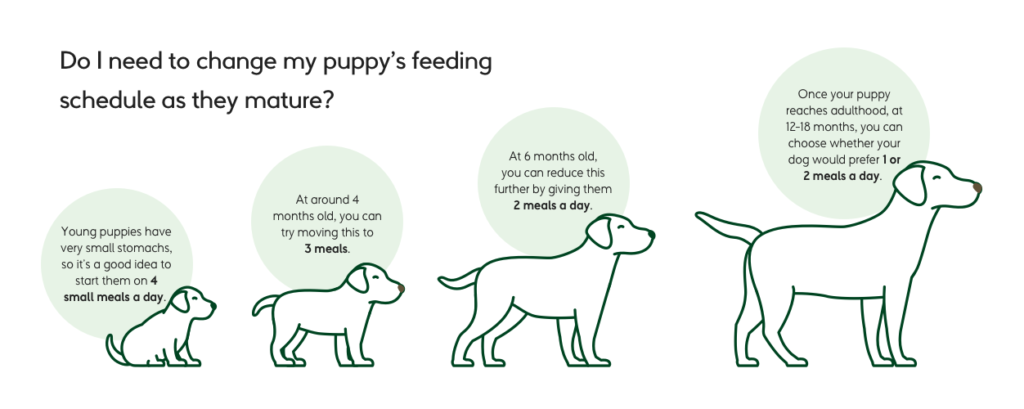Everything you need to know about feeding your puppy
In association with MORE THAN insurance
Just like children, puppies need proper feeding to ensure they grow up healthy and strong. But getting to grips with the ins and outs of feeding your puppy can be overwhelming. We thought it might be helpful to share some Good Advice from our very own Vicki Mark. Vicki is a Puppy Manager overseeing our breeding scheme and ensuring that our volunteers and their puppies get all the support they need to help them become our future assistance dogs.

What should I feed my puppy?

At Dogs for Good, our assistance dogs and puppies are fed on dried kibble provided by Royal Canin. Our friends at MORE THAN have put together some great information about the different types of food available by their in-house vet, Martin.
How often should I feed my puppy?
Very often, food bags will come with a chart which you can use as a guide to feeding your puppy. Every dog is different and like humans, have different metabolisms, but as a general rule, puppies aged:
Up to 3 months: feed four meals a day
3-6 months: feed three meals a day
6+ months: feed two meals a day
Vicky says it’s good to keep it simple when you’re introducing a new puppy into your home. “They’re dealing with a great deal of change and while you’re giving them loads of love and affection, remember that everything has changed in their life and adding lots of different new foods to their diet is likely to upset their tummies.”
Every pup has a minimum requirement of food that they need to ensure that their daily nutritional needs are met.
Vicky advises: “Aim to feed your puppy at a similar time each day so that their food is releasing all its nutritional benefits gradually over the course of the day. Also, try to ensure that you don’t give them food directly before or after play sessions or free-runs/walks.”
My puppy isn’t interested in their food
Although the breeds we work with at Dogs for Good tend to be very food motivated, some puppies might not be that interested. “You might find that your puppy is a bit hit and miss with their food,” says Vicky. “They may refuse to eat for a day and that can obviously cause concern because getting the right nutrients is important to a growing pup. But, I wouldn’t advise immediately changing their food as sometimes this can result in upsetting their tummies.” Vicky says that it’s a good idea to take a look at their environment first and see if you can notice anything going on there that could easily be changed.
“It could be something simple such as their collar disc banging on the side of their bowl or their bowl being too near the wall or in a corner so they can’t see around them. Also, other pets in the household might stare and scare them while they eat – cats are quite good at this and it’s easy to see how it might unnerve a puppy!” says Vicky. You could also try feeding your puppy in their crate, further reinforcing this space as a safe space.
Once you’ve had a look at their environment, you could try enticing them a little by mixing their food with a spoonful of gravy or something different and smelly and see if that does the trick. “Some dogs are just fussy,” says Vicky. “Some of the golden retrievers we work with aren’t bothered by kibble but mix it with a bit of gravy and it’s a different story!”
If nothing works and your pup is still refusing food, be sure to seek advice from your vet.
Reducing your puppy’s mealtimes
Puppies still need the appropriate amount of food inside them to keep them healthy as they grow but as they get older, they don’t need it as frequently. “Some people feel bad when they start to reduce mealtimes down from four to three times a day and so on,” says Vicky. “But remember that they aren’t ‘missing’ a meal as you’ll still be feeding your puppy the right amount of food over the course of a day but you’re doing it in two meals rather than three.”

My puppy is having a growth spurt
Puppies grow and they grow quickly! “Puppy growth spurts are incredible and it’s important to ensure that you keep an eye on it because growing requires food to balance out the changing need for nutrients and keep your puppy healthy.” We advise feeding your puppy a little bit more food during a growth spurt and then dial it back to normal once things have calmed down again.
How much should my puppy weigh?
Getting puppies to stay still on scales can be tricky but fortunately, your eyes are also a good way to check that your dog is at a healthy weight. “Every dog has a different shape,” says Vicky. “For example, dogs with strong show lines tend to be a little heavier – although still within a healthy range – than dogs with strong working lines.” The way to check weight by eye is to ensure you look at the dog from all angles. “You’re looking for a waist which is best viewed from above and an abdominal tuck which is more visible from the side. Also run your hands over their sides and push against their ribs very gently; you’re after a feeling of general padding but not too much or too little.” Vicky also advises that the neck is an area where you might see a little extra padding. “Look at the lower part of the neck where it starts to meet the chest and if it’s too squishy, it might be that that’s the area your dog hides a sneaky bit of weight.”
What treats should I give my puppy?
“Try to keep treats to one or two puppy specific and/or natural treats such as sprats or carrots,” says Vicky. “Also, remember that while they’re nutritionally excellent, sprats are also oily and therefore high in calories so use your judgement and err on the side of caution in terms of how many you offer your puppy in a day.”
Using treats when you’re walking your puppy
There’s no ‘set’ amount of treats you can give a puppy while you’re out and about but it’s obviously important to gauge the amount of food rewards you take with you to the amount of time you’ll be out. “Generally speaking, we advise our socialisers to take a handful of kibble from their pups’ daily food allowance and also maybe half a chopped up carrot and a few squares of ham to mix things up a bit. With very young pups, you’re not likely to be going very far so you won’t need to take a huge amount with you,” says Vicky.
Vicky also says it’s a good idea to start off with a high reward ratio. “At first, almost every step you take, you want to reward your puppy and keep them engaged with you. As they get used to things over the weeks to come, you can start to dial it down to every five steps and so on.”
Another important thing to think about is the ‘hierarchy of reward’. “Just because you think that bit of delicious cheese is reinforcing, it doesn’t mean your puppy is necessarily in agreement,” says Vicky. “Learn what your dog loves and make sure you use the most desirable treats for them making the best choices.” Recall is an excellent example. “If you’re out on your walk and you end up calling your puppy three times before they take any notice of you, reward with a bit of kibble. If they only need two calls, reward with a sushi treat or similar. If they’re spinning on their heels and coming back before you’ve even got the cue out of your mouth… it’s time to break out the sprats!”
And don’t forget, even when your dog is older, continue to reward them for making the right choices. “One of my dogs is 13,” says Vicky. “He knows what’s what but I still continue to reward him for being a lovely boy out on a walk. I’m continuing to interact with him, building on our time together positively and letting him know he’s a good boy.”
Can I give my puppy chews?
It’s good to remember that puppies have tiny, skinny baby teeth and therefore, we wouldn’t advise giving a puppy a hard chew until they’ve got their adult teeth through. Even then, it’s still advisable to use slightly softer, puppy-specific chews until they’re older and stronger.
Using food as enrichment
Generally, we think of exercise in the more physical sense but using food as enrichment gives your puppy mental exercise and an outlet to use their brains and engage with their senses by sniffing, scavenging and problem solving. Mental enrichment with food helps to build up their tolerance, resilience and stamina so they can learn to manage their own frustration levels. “It doesn’t matter whether a puppy is going on to be a companion dog or an assistance dog, using food and interactive toys as mental enrichment is a fantastic way to help your dog learn,” says Vicky. “And they’re called interactive toys for a reason – get involved with your puppy! Lots of encouragement and praise from you to let them know how well they’re doing is all part of the experience and will help to build that all-important bond between you.”
Make sure that you take the food you’re going to use from their daily allowance so you don’t end up over-feeding your puppy.
Using food to help your puppy relax
Kongs and Licky Mats encourage, unsurprisingly, licking! Licking promotes a calming, soothing feeling for your pup and helps to release relaxing endorphins.
“We prefer to use Kongs to help our puppies get used to crates and then again when they’re older to help teach them to settle as part of their task work. A Kong doesn’t take up much room and makes the crate a nice place to be for your puppy,” says Vicky. “We use Licky Mats to help our puppies get used to being calm during health checks, bath time and also with getting used to being in the back of a car. Most of them can be stuck onto surfaces so you can use them almost anywhere.”
Using food as a positive reinforcer to new activities
At Dogs for Good, our puppies are looked after by our fantastic volunteer socialisers; a band of people devoted to giving our pups the best start in life and helping them experience all the wonders of the world in a safe and positive way. “Using food rewards is a great way to help your dog make the right choices especially in new situations,” explains Vicky. “For example, our puppies will need to be comfortable in supermarkets as part of their life as an assistance dog, so our socialisers start this off very gradually. They will begin by simply sitting on a bench outside the supermarket with their pup, letting the puppy watch the world go by for five minutes, all the time using food rewards to keep the experience positive and calm. You can do this with your own puppy as part of his or her socialisation – perhaps if you want to travel with your puppy eventually, you can start off sitting in the back of the car doing the same sort of thing.”
Self-control and good manners
Meal times can easily become a bit of a riotous affair and letting this get out of hand can bring problems as your little puppy turns into in adult dog… especially if it’s a bigger breed. “Just like children, puppies need to learn how to tolerate their own frustration levels so setting boundaries around mealtimes is a great way to do this,” says Vicky. “Mealtimes can be moments of high stress for some dogs and it’s all part of responsible dog ownership to ensure that you teach them that being calm means they get their food.” At Dogs for Good, we train our puppies to keep ‘four paws on the floor’ until they’re calm and then we put their bowl down. We then ask them to sit and wait until they’re given a whistle or verbal cue to eat their food. If they jump up, we don’t scold them, they simply have to wait longer for their food. “If you’re consistent, it won’t take too long for your puppy to work out that jumping up at you and barking while you’re preparing their food isn’t the right thing to do,” says Vicky.
Once the bowl is on the floor, some dogs eat their food so quickly it’s almost like they’re inhaling it! Which isn’t great as it makes digesting that food even harder on their tummies and for deep-chested dogs, it can cause bloat and gastric torsion. “Consider a slow feeder if your puppy is a food hoover,” says Vicky. “We use the ‘bucket game’ in our puppy classes which is a very positive way to teach puppies a little self-control.”
Help support our life-changing work...
Imagine if everyday tasks were so challenging or physically demanding they affected your quality of life. For many people living with a disability of families with a child with autism, that is their reality. Now imagine if a specially trained four-legged friend could restore your, or your family’s, independence.
The demand for our services is high and we can’t help as many people as we would like to without more funding. Please help us continue making life-changing differences for people with disabilities through the power of expertly trained dogs.
Every contribution, whatever size, is important and helps us make a difference.


